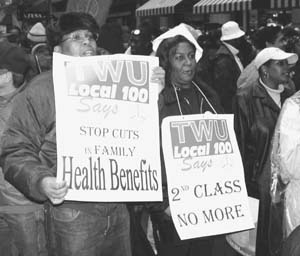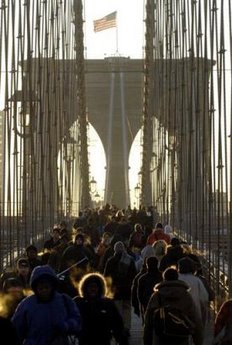Contract talks broke off between New York transit and union negotiators last night [ed's note: we published this in 2005] without an agreement (just before the midnight strike deadline). 34,000 workers have gone on strike. Seven million people a day need to find another way to get around.
Mayor Michael R. Bloomberg announced a "comprehensive emergency plan" to help mitigate the effects of the strike with more ferry service, only car pools allowed into Manhattan, several major streets, including Fifth Avenue, clear of all traffic except buses and emergency vehicles. I believe taxis are also required to pool riders (as they did in 1980).

We lived in Manhattan during the 1980 strike. It started on April Fool's Day and lasted 12 days.
According to nycsubway.org, the absentee rate during the strike was around 15-20%. That may be true, but those of us who actually showed up for work didn't make it in until very late, and everyone left early. It was basically a circus atmosphere all over town. Employers were glad to have us show up for even a few hours a day. Even the most skinflint of employers (and that would include mine, Carl Fischer music publishers) paid people to share cabs in to work. The cab ride from the Upper West Side to the East Village took about two hours...barely faster than walking. It was a total zoo, with gridlock everywhere, and thousands of cops on traffic duty to contain the honking, chaos, and (literally) millions of pedestrians.

Heading to work on The Brooklyn Bridge
I don't remember road rage, or riots, or people being particularly angry. In fact, it was like anytime things went wrong: New Yorkers pulled together; they griped and kavetched, and they lived with it, and had a pretty good time doing it. I remember the endless commutes, schlepping back and forth from uptown to downstown. I remember sharing cab rides with Arthur Cohn (the cranky, funny composer and conductor known for his books on contemporary music, The Collector's 20th-Century Music in the Western Hemisphere and 20th-Century Music in Europe), Susan Lurie, a friend and excellent flautist, and at least one other person, possibly Pinky Rawsthorne. . .although if she was in the cab I think I would have remembered it, because there would have been a lot more laughter.
The New York Post Transit Survival
Guide - Click to enlarge
In 1980, the subways were dirty, dangerous, smelled, tended to catch on fire at times, had no air conditioning, and were covered with tags and graffiti. And boy, did we miss them. After returning home at night, you stayed in your neighborhood, or within walking distance anyhow. Somehow they settled it all in a couple of weeks. Good luck New York!
---o0o---


No comments:
Post a Comment
What do you think?